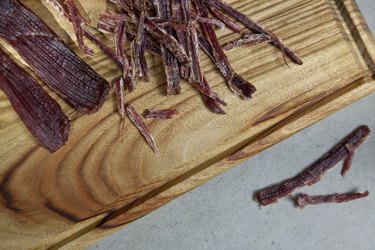
Store-bought beef jerky is known for its salty flavor, but you actually don't need any salt at all to make a soft and tender beef jerky recipe. You can season the meat any way you'd like, but the only two vital components are meat and a dehydrator — and the process is easier than you may think.
While you may be looking for a low sodium beef jerky recipe, it's actually more important that you pay attention to internal temperatures of the meat. You can make beef jerky safely at home, but it takes some extra care to make sure it's safe.
Video of the Day
Video of the Day
Low Sodium Beef Jerky Recipe
To make homemade low-calorie beef jerky without added salt, choose a lean meat that doesn't have a lot of visible fat. Slice off any excess fat and cut the meat, with the grain, into quarter-inch slices. If you'd like, you can marinate the beef in your favorite low-sodium marinade, but make sure to store it in the refrigerator while it's marinating.
If you're making a low salt ground beef jerky recipe, the University of Wisconsin Extension recommends using ground beef that's at least 93 percent lean. However, North Dakota State University adds that using whole muscle meats for at-home jerky processing is usually a safer option. Ground meats tend to carry potentially harmful bacteria more readily than other cuts and it's better to be safe than sorry.
When your meat is ready to cook, preheat the dehydrator to 155 degrees Fahrenheit. Arrange your sliced meat on the dehydrator trays and let the meat dehydrate for at least four hours, or until the jerky has reached your desired consistency. Avoid opening the dehydrator doors before the four-hour minimum has passed, as this can let the heat escape and cause the temperature to drop too low.
Consider Food Safety
While your main focus may be on how to make a healthy beef jerky recipe in the dehydrator, you also need to consider proper food safety techniques. Most dehydrators available for sale only heat the beef to 130 to 140 degrees Fahrenheit. According to the USDA Food Safety and Inspection Service, this isn't adequate enough to kill pathogenic bacteria like E. coli and salmonella that can live in the beef and cause foodborne illness and the uncomfortable symptoms that come along with it.
There is a way to get around this, though, and that's by heating the beef to an internal temperature of at least 165 degrees Fahrenheit before you dehydrate it. You can do this in the oven or on the stove top, whichever you prefer. Adding this step, which isn't always recommended in a dehydrator's instruction manual, assures that any bacteria in the meat will be killed by wet heat.
Instead of pre-cooking the meat, the University of Minnesota Extension notes that you can also freeze it prior to dehydrating (this will make it easier to cut into thin slices, too) or cook it in a 275 degree F oven for 10 minutes after the meat has been dehydrated.
After adequately heating or freezing the meat, you also want to make sure that the beef stays at a temperature between 145 and 155 degrees F the entire time you're dehydrating it. If the temperature drops too much, the cooked meat can spoil during the dehydration process and this can put you at risk of food poisoning, too. Make sure your dehydrator can handle this level of heat, as lots of options on the market can't, according to the University of Wisconsin Extension.
- USDA Food Safety and Inspection Service: "Jerky and Food Safety"
- University of Wisconsin Extension: "Making Safe Jerky in a Home Dehydrator"
- University of Minnesota Extension: "How to Safely Make Homemade Jerky"
- North Dakota State University: "Jerky Making: Producing a Traditional Food With Modern Processes"